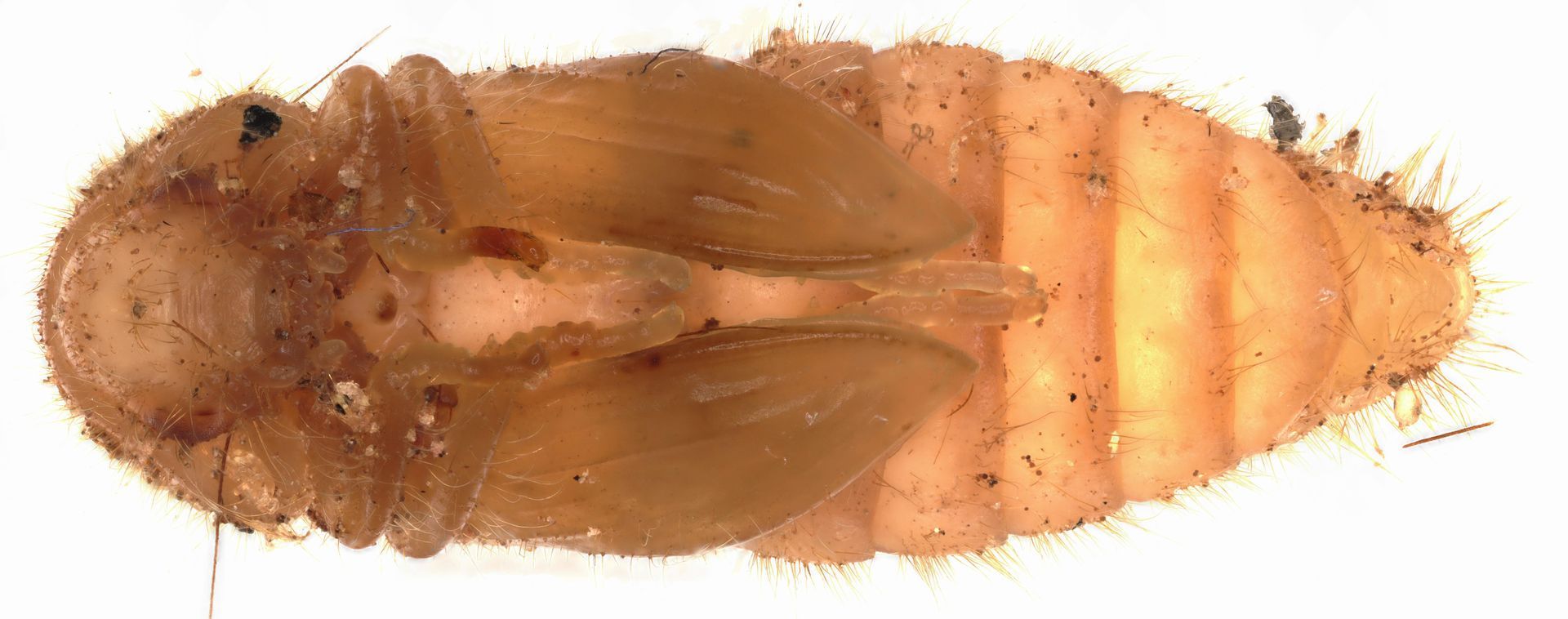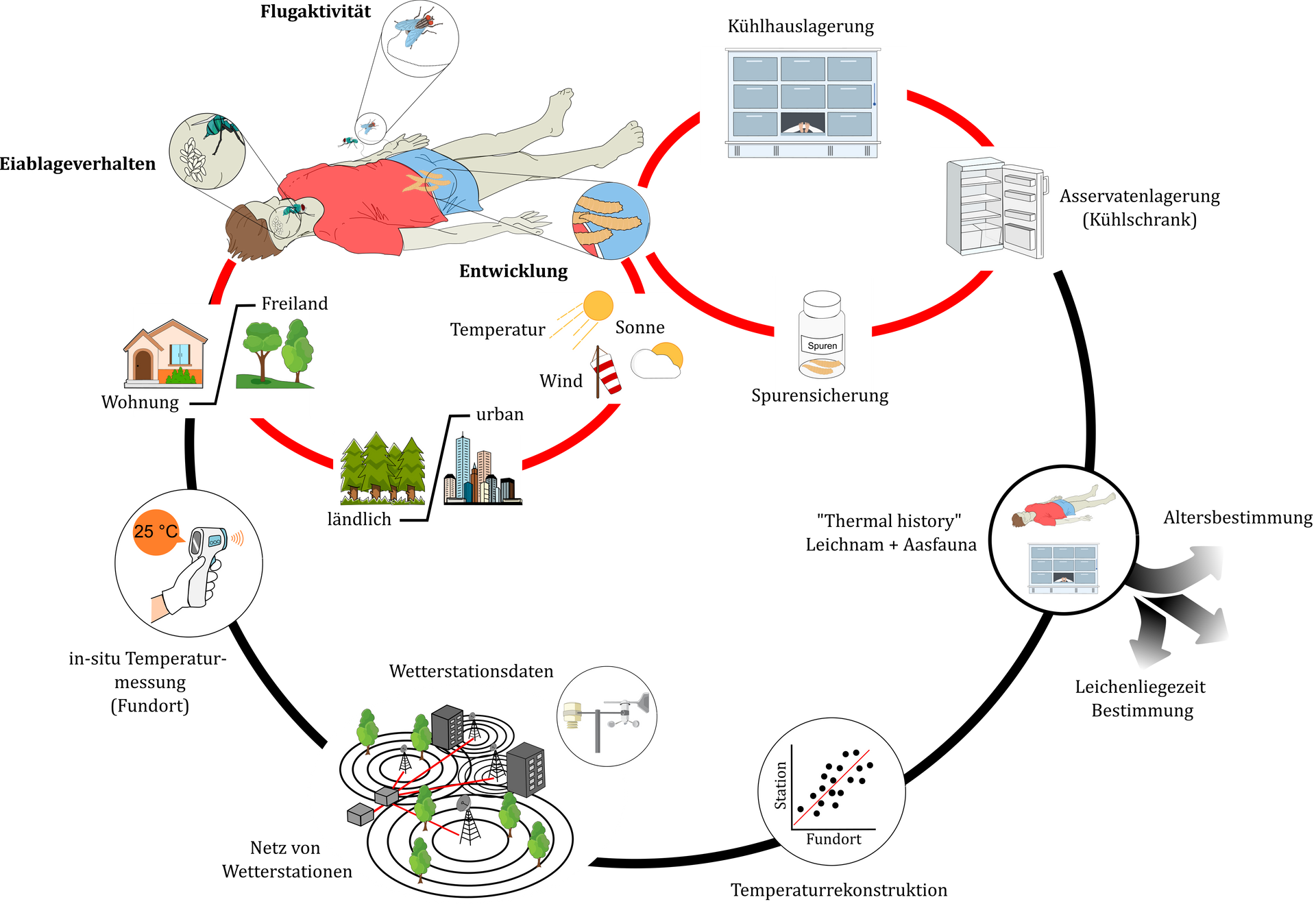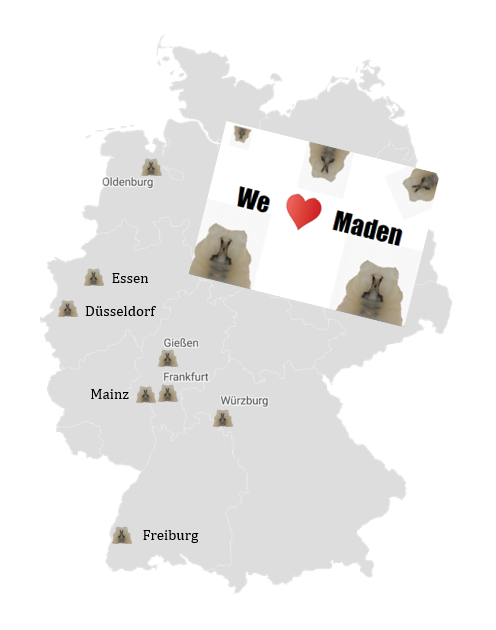
The systematic scientific treatment of forensic entomological questions has only increased significantly in the last 25 years. Every entomological case in forensics has its own special environmental conditions and always raises new questions with an ecological, physiological, molecular-biological or even toxicological background. Our various research projects, which are presented below, are dedicated to answering these questions:
Age determination of forensically relevant blowfly species during the pupal stage

While the age of blowfly larvae can be determined quite easily by measuring the length of the larvae, determining the age of blowflies in the pupa is difficult, as the metamorphic changes that take place inside the pupa are not visible from the outside. For this reason, it is standard to breed the live animals until their emergence as adult. Although other methods can be used to determine the age of dead material, these are usually more complex or costly, such as gene expression analysis or the analysis of histological changes. A visible accessment of the inside of the morphological changes
within the pupa can provide information on age, but since this is not a quantitative method it and can lead to large age differences depending on the observer. For this reason, we are establishing new quantitative methods to enable precise and quantifiable age determination of blowflies in the pupal stage of dead material. In addition, the different methods should be combinable, so that several different methods can be used simultaneously to age a single pupa, thus increasing the accuracy of the age determination.
There are currently three different projects on this topic:
Age determination using changes in the eye pigmen-tation during the pupal stage
Once the eye structure is formed during metamorphosis, various pigments (such as pteridine) are deposited in the eyes, resulting in an increase of red coloration. We reproduce this increasing pigmentation throughout the pupal development of the forensically relevant blowfly Lucilia sericata by killing pupae at regular intervals and photographing the eyes with a digital microscope at 100x magnification. Once all the images have been normalized to the defined RGB color value of the background, the changes in RGB values during metamorphosis can be used to develop models to determine the age of L. sericata pupae.


Changes in the composition of pupal cuticular hydrocarbon
The cuticular hydrocarbons (CHCs) found on the surface of insects have a variety of functions, for example as a protective layer against dessication. They vary greatly in function and composition between species and can therefore be considered as a kind of chemical fingerprint of the insect. As other research groups have shown, the composition of CHCs changes during juvenile development. These CHCs are extracted and analyzed using a mass spectrometer coupled to a gas chromatograph (GC-MS). When compared with existing reference data, the composition of the CHCs can provide information on the age of the pupa analyzed.
FTIR spectroscopic measurements of different parts of the pupa
Fourier Transform Infrared (FTIR) spectroscopy is a non-invasive method based on the natural vibrations of molecules and their ability to absorb electromagnetic radiation. It can therefore be used for the biochemical characterisation of a wide range of biological materials and is often utilized in forensic cases, for example to analyze different fibres and colors, or even blood stains. As it is a rapid and cost-effective method for the charac-terization of different materials and biological traces, it has a great potential for applications in forensic entomology.
We are currently investigating the applicability of this method in the context of age determination of pupae of the forensically relevant blowfly
Calliphora vicina. For this, different pupal preparation methods are being tested for their success in determining the pupal age, and first reference data for the age determination of this species is being collected.

Species (and age) determination of weathered blowfly puparia or their fragments

At older crime scenes/locations, empty pupal cases (puparia) are often the last remaining traces of insect colonization of a corpse. If the insect species can be identified, this can provide important information about the approximate time of death, such as the season, even years later.
However, identifying the species of these puparial fragments is morphologically almost impossible. For this reason, we try to determine the species using biochemical methods. One way of doing this is to analyse the CHC of the puparial fragments using GC-MS, which can give an indication of the species or even the approximate age of the puparia. However, the faster method of FTIR spectroscopy also offers promising possibilities for an identification of even the smallest fragments. And at the same time, we are also collecting data for an estimation of the rough age of the weathered puparia. All of this data will then be used to develop mathematical models that can help in future case studies.
Temperature reconstruction
For an accurate estimate of PMImin, precise knowledge of the temperature to which necrophagous insects were exposed during their development on a carcass is essential. Accordingly, reconstructing the temperature at the crime scene is an inevitable step in any death investigation and should be treated with care. Errors that arise here can have far-reaching consequences for determining the age of forensically relevant insects and thus also for the expert assessment of the entomological traces. Despite a large number of published guidelines and the general importance of accurate temperature reconstruction for forensic casework, the topic is still controversial and the use of statistical models to reconstruct temperature is rare to non-existent.

In recent years, our working group has developed a new method for reconstructing the temperature of the crime scene, which has since been used in various criminal cases. Models are currently being tested in which various biotic and abiotic variables that influence the temperature at the site are included in order to make the reconstruction even more precise.
Modeling the flight and oviposition activity of necrophagous flies
Despite various new applications, estimating the time since insects first colonized a corpse is still the main goal of forensic entomology. Each PMImin estimation is linked to several, often case-specific, assumptions. One of these basic assumptions is that colonization of a corpse by insects occurs immediately after death. It is well known that this does not correspond to reality and that there are often delays between the death and the colonization by insects. In order to explain this “gap” and to adequately evaluate entomological traces, it is important to understand and quantify the oviposition behavior of necrophagous flies. In order to gain a better understanding of the influence of biotic and abiotic factors on the colonization times of forensically relevant insects, our working group examined the oviposition activity of necrophagous flies (Calliphoridae, Sarcophagidae) using mouse carcasses.

These were placed at ten locations in an urban and a rural habitat in Frankfurt am Main on 240 days over a period of two years. The data was used to model seasonal oviposition activity and the influence of environmental parameters on the probability of oviposition for each species individually. The overall goal was to identify and understand possible species-specific climatic and seasonal adaptations of forensically relevant species. We showed that seasonal adaptation (the phenology of each species), habitat (rural vs. urban), and temperature are the most important factors influencing egg-laying behavior and activity of necrophagous blowflies and flesh flies. We are currently working on a model that also allows us to predict the probability of colonization of human corpses in the greater Frankfurt area.
From Crime Scene to Autopsy – Changes in the decomposition and insect colonization
The gold standard in both legal medicine and forensic entomology is the collection and preservation of evidence the time a body is found, including post-mortem examination and subsequent dissection. However, there are sometimes several days between these events, during which changes can occur. In order to record these changes and to ensure a high quality of forensic working methods, the project compares the findings (insect colonization, postmortem changes) during the mortuary examination and the autopsy. The focus is on the postmortem changes to the corpse (legal medical perspective) and the entomological findings (entomology), over time from the discovery of the corpse to the subsequent dissection in our institute. The postmortem changes are classified based on photos (scene, autopsy) using various “decomposition markers”. The entomological findings are analyzed based on the species composition and developmental stages found in the samples. In addition, temperature measurements are taken directly at the discovery site and a data logger in the body bag records the temperature profile from the discovery site to the autopsy.
Improving daily casework
In addition to precise knowledge of the temperature, proper preservation of insect evidence is essential for an entomological report, the estimation of the PMImin and thus also for expert testimony in court. Based on several published guidelines, the gold standard for casework is immediate preservation of entomological evidence at the site and during autopsy by a trained forensic entomologist. Unfortunately, this procedure does not correspond to reality and forensic entomologists are often not called to a discovery site, which means that their own assessment, including the collection of evidence and temperature measurements, is not possible. Thus, in the majority of cases, an entomological report is based exclusively on information such as photos, police reports and traces obtained from third parties such as police officers, forensic doctors or non-medical experts. Our working group investigates the problem of incorrect evidence preservation and considers the difference between the preservation of entomological traces at the discovery site and at the autopsy with regard to the influence of the estimate of the minimum PMI and the quality of an entomological report. The aim is to develop new guidelines for daily case work.
Collaborations
Interdisciplinarity is essential to further develop current methods in forensic medical routine and research, but also to create productive collaboration between different disciplines, such as entomology and medicine. Although insects have proven to be a common and helpful evidence in criminal cases, they are currently still too rarely used in legal investigation. As a result, there is no comprehensive data on the distribution, seasonal activity and frequency of forensically relevant insects on human cadavers. In order to expand the entomological research of the Institute of Legal Medicine geographically and ecologically, insect-associated cases from other Institutes of Legal Medicine in Germany have also been collected and analyzed since 2021. There are currently close collaborations with the Institutes of Legal Medicine in Gießen, Oldenburg, Würzburg, Freiburg, Düsseldorf, Mainz and Essen.


